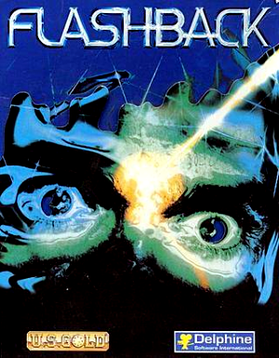
Flashback, released as Flashback: The Quest for Identity in the United States, is a 1992 science fiction cinematic platform game developed by Delphine Software of France and published by U.S. Gold in the United States and Europe, and Sunsoft in Japan.

Cool Spot is a 1993 platform game developed by Virgin Games USA for the Mega Drive/Genesis, Super Nintendo Entertainment System, Master System, Game Gear, Game Boy, Amiga, and MS-DOS. The title character is Cool Spot, a mascot for the soft drink brand 7 Up. Cool Spot's appearance in his own video game came at a time when other brand mascots were appearing in their own video games.

Pitfall: The Mayan Adventure is a side-scrolling action-platform video game developed by Activision in conjunction with Kroyer Films and originally published in North America and Europe in 1994. The fourth installment in the Pitfall! franchise, players assume the role of Pitfall Harry Junior as he embarks on a journey through the Mayan jungles of Central America in an attempt to rescue Pitfall Harry, his father and the protagonist of previous entries in the series, from the evil Mayan warrior spirit named Zakelua. Its gameplay mainly consists of action and platforming mixed with stage-based exploration using a main six-button configuration.

Jungle Strike is a video game developed and published by Electronic Arts in 1993 for the Sega Genesis/Mega Drive. The game was later released on several other consoles such as the Super Nintendo Entertainment System (SNES), and an upgraded version was made for DOS computers. The Amiga conversion was the responsibility of Ocean Software while the SNES and PC DOS versions were that of Gremlin Interactive, and the portable console versions were of Black Pearl Software. It is the direct sequel to Desert Strike and is the second installment in the Strike series. The game is a helicopter-based shoot 'em up, mixing action and strategy. The plot concerns two villains intent on destroying Washington, D.C. The player must use the helicopter and occasionally other vehicles to thwart their plans.

The Sega Genesis, also known as the Mega Drive outside North America, is a 16-bit fourth generation home video game console developed and sold by Sega. It was Sega's third console and the successor to the Master System. Sega released it in 1988 in Japan as the Mega Drive, and in 1989 in North America as the Genesis. In 1990, it was distributed as the Mega Drive by Virgin Mastertronic in Europe, Ozisoft in Australasia, and Tectoy in Brazil. In South Korea, it was distributed by Samsung Electronics as the Super Gam*Boy and later the Super Aladdin Boy.
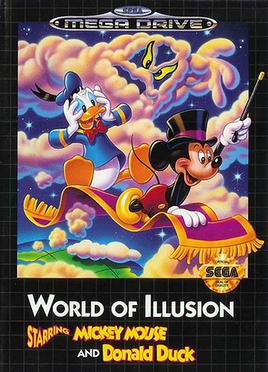
World of Illusion Starring Mickey Mouse and Donald Duck is a platform game developed and published by Sega for the Sega Genesis. The game was released in December 1992, and is part of Sega's Illusion series of Mickey Mouse games. The game was included on the Sega Genesis Mini.
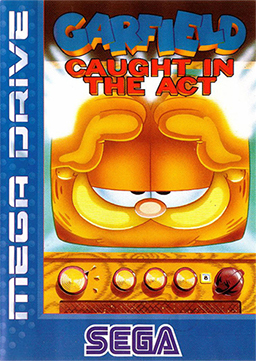
Garfield: Caught in the Act is a 1995 side-scrolling platform game developed and published by Sega for the Genesis and Game Gear. A Microsoft Windows version followed. It is based upon Jim Davis' comic strip cat, Garfield, and draws inspiration from Davis' 1984 book Garfield: His 9 Lives. Odie scares Garfield while they are watching television and they fall on the TV, breaking it. Both characters attempt to repair it before Jon Arbuckle catches them; however, the thrown spare parts become an electronic monster known as the Glitch, transporting Garfield into the TV, where he must defeat him in order to get out.
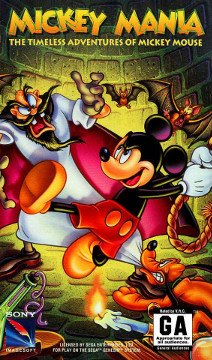
Mickey Mania: The Timeless Adventures of Mickey Mouse is a 1994 platform video game developed by Traveller's Tales and published by Sony Imagesoft for the Super NES, Sega Genesis and Sega CD. In the game, the player controls Mickey Mouse, who must navigate through various side-scrolling levels, each designed and based on classical Mickey Mouse cartoons. The game was later released on the PlayStation in 1996 as Mickey's Wild Adventure in PAL regions by Sony Computer Entertainment, Sony Imagesoft's successor. A second game, Mickey Mania 2, was intended to be released, but was cancelled due to Traveller's Tales focusing on other games.

Disney's The Jungle Book is a series of platform video games based on the 1967 Disney animated film of the same name. The game was released by Virgin Interactive Entertainment in 1994 for the Game Boy, Nintendo Entertainment System, Master System, Genesis/Mega Drive, Game Gear, Super Nintendo Entertainment System, and MS-DOS. While gameplay is the same on all versions, technological differences between the systems forced changes – in some case drastic – in level design, resulting in six fairly different versions of the 'same' game. This article is largely based upon the Genesis version.

Global Gladiators is a 1992 platform game developed by Virgin Games USA, originally programmed by David Perry for the Sega Genesis and eventually ported by other Virgin Games teams in Europe to the Master System, Game Gear, and Amiga. The game is based on the McDonald's fast food chain and has a strong environmentalist message.

Maui Mallard in Cold Shadow – originally released as Donald in Maui Mallard – is a platforming video game developed and published by Disney Interactive Studios. The game was released in Europe on December 8, 1995, and in Brazil in spring 1997 for the Sega Mega Drive. It was also ported by Eurocom Entertainment Software to the SNES and released in North America in January 1997, in Europe mostly in autumn 1996, and in Japan on December 20, 1996. A Microsoft Windows port was released in North America in November 1996. It was ported one last time to the Game Boy by Bonsai Entertainment Corp., released in North America in August 1998.
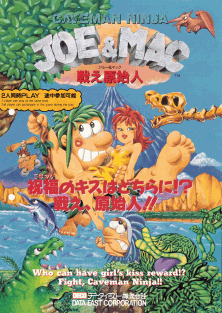
Joe & Mac, also known as Caveman Ninja and Caveman Ninja: Joe & Mac, is a run and gun platform game released as an arcade video game by Data East in 1991. It was adapted for the Super NES, Mega Drive/Genesis, Nintendo Entertainment System, Game Boy, Amiga, Zeebo, Nintendo Switch, and IBM PC compatibles.

The Lion King is a platform game based on Disney's 1994 animated film The Lion King. The game was developed by Westwood Studios and published by Virgin Interactive Entertainment for the Super NES and Genesis in 1994, and was ported to MS-DOS, Amiga, Game Gear, Master System, and Nintendo Entertainment System. The Amiga, Master System, and NES versions were only released in the PAL region. It is the final licensed NES game worldwide. The game follows Simba's journey from a young cub to the battle with his uncle Scar as an adult.
Disney's Magical Quest is a Disney platform game trilogy released by Capcom. The games star Mickey Mouse and either Minnie Mouse or Donald Duck, who must defeat Pete. The gameplay is similar amongst all games in the series: the player must move as in a typical platform game, defeating enemies either by jumping on them or by grabbing and throwing blocks at them.
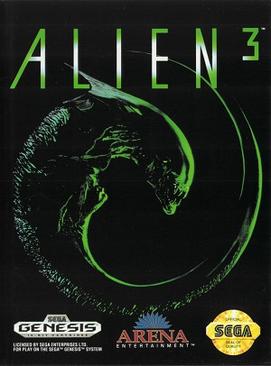
Alien 3 is a run and gun game based on the 1992 film of the same name. It was released for the Genesis and Amiga in 1992, then for the Commodore 64, Game Boy, Game Gear, Nintendo Entertainment System, Super Nintendo Entertainment System, and Master System.

Taz Mania is the name of several video games based on the Taz-Mania cartoon series. A 2D side-scrolling platform/adventure video game developed by Recreational Brainware and published by Sega on the Sega Mega Drive/Genesis in 1992. Different games were also developed by NuFX and released on the Game Gear and by Technical Wave on the Master System. Other different Taz-Mania games were also published by Sunsoft in North America and by THQ in PAL terrotories and released on the SNES and 2 games on the Game Boy were made too. One from David A. Palmer Productions and published by Sunsoft and another one called Taz-Mania 2 from Beam Software and published by THQ.

The Incredible Hulk is a 1994 video game released for the Mega Drive, Master System, Game Gear, and SNES. Developed by Probe Software and published by U.S. Gold, the game is based on the Marvel Comics superhero Hulk and showcases him within the context of a side-scrolling action game with platforming and beat 'em up elements. The narrative involves the Hulk attempting to thwart the world domination bid of his nemesis, the Leader, while engaging in combat with other arch-rivals.

Dragon: The Bruce Lee Story is a fighting video game developed and originally published by Virgin Interactive Entertainment in Europe for the Sega Genesis in June 1994. It is based on the 1993 film of the same name, which is a semi-fictionalized account of the life of Hong Kong-American actor and martial artist Bruce Lee. Following the events of the movie, players take control of Bruce Lee across several stages that takes places in different time periods of his life and fight against some of his adversaries.

Aladdin is a Disney media franchise comprising a film series and additional media. It began with the 1992 American animated feature of the same name, which was based on the tale of the same name, and was directed by Ron Clements and John Musker. The success of the film led to two direct-to-video sequels, a television series, a Broadway musical, a live-action remake, various rides and themed areas in Disney's theme parks, several video games, and merchandise, among other related works.
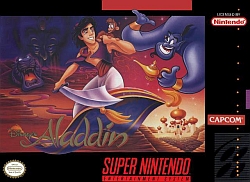
Disney's Aladdin is a 1993 platform game developed and published by Capcom for the Super Nintendo Entertainment System, based on the 1992 animated Disney film of the same name. Disney's Aladdin is a 2D side-scrolling video game in which the player controls Aladdin and his monkey Abu. It was designed by Shinji Mikami.



















